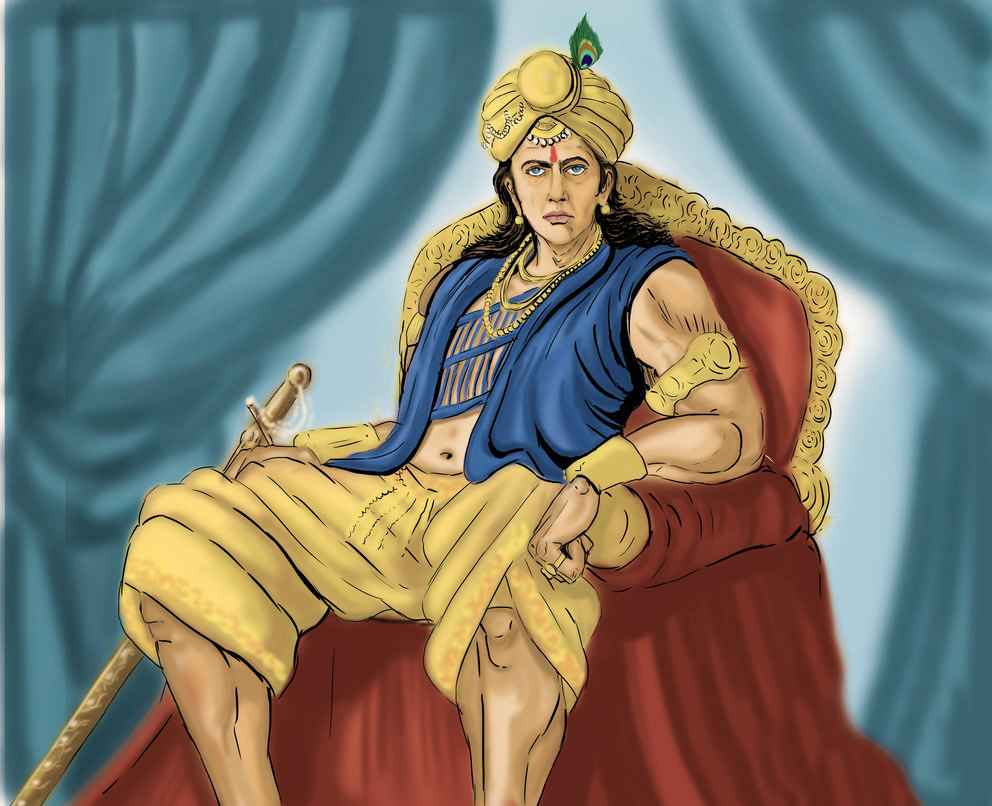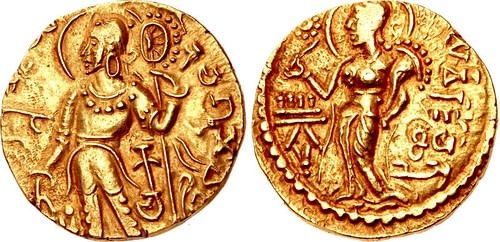
Samudragupta (335/350 - 370/380 CE) was one of the greatest emperors of ancient India and his reign marked the height of the Gupta Empire. Born in 335 AD, he succeeded his father Chandragupta I to the throne and went on to expand the empire to new territories, making it one of the strongest and largest empires in India during that period. With his military conquests and cultural achievements, Samudragupta's reign is regarded as a golden era in Indian history. In this blog, we will explore the life, achievements and legacy of this remarkable emperor and delve into the reasons behind his rise to greatness. He was succeeded by his son, Chandragupta II, who continued his father's legacy of military conquests, cultural patronage, and administration.
Samudragupta's inscriptions:
- They are four in number, two are Prashastis and two are land charters. The Samudragupta Prashastis are located at Allahabad and Eran, MP.
- Samudragupta Prashastis, Allahabad: One of the most significant records of Samudragupta's reign is the Samudragupta Prashastis, a group of inscriptions found at Allahabad in northern India composed by a high-ranking official named Harishena. These inscriptions provide valuable information about Samudragupta's life, his achievements, and the administration of the Gupta Empire.The Samudragupta Prashastis are written in Sanskrit and are engraved on three different rocks at Allahabad. The first inscription, known as the Allahabad Pillar Inscription, is the longest and most detailed of the three. It provides a comprehensive account of Samudragupta's military conquests and his achievements in the field of arts and culture. The second inscription, known as the Eran Inscription, is shorter but provides important information about Samudragupta's administration and his role in the governance of the empire. The third inscription, known as the Kausambi Inscription, is the shortest of the three but provides important details about Samudragupta's military victories and the geographical extent of his empire.
- Of the two land charters, one is Nalanda Copper Plate inscription. It is talking about an Agrahara (village) given to a Brahmin (entire revenue of the village will go to the Brahmin).
- The other land charter is Gaya Copper Plate inscription. It talks about a village donated to a Buddhist Vihara, which was built by Meghavarna, a king of
Sri Lanka. Gupta kings are Vaishnavites. But, they contributed to Buddhism also.
Political Expeditions and expansion: Samudragupta is known chiefly for his numerous military campaigns. The British historian Vincent Smith (1848 – 1920 CE) was the first to dub him as 'the Indian Napoleon'. His many conquests have been alluded to in the Allahabad pillar inscription.Samudragupta expanded the Gupta Empire through several successful military campaigns against neighboring kingdoms and tribes.In the north he played the part of a digvijayi or “conqueror of the quarters,” of the Early Magadhan type. But in the south he followed the Epic and Kautilyan ideal of a dharmavijayi or “righteous conqueror,” i.e., he defeated the kings but did not annex their territory.
North Indian Campaign:Samudragupta first focused on the lands bordering the existing Gupta Empire at the time. He invaded the monarch of the upper Ganga valley and defeated many other kings, including Rudradeva, Matila, Nagadatta, Chandravarman, Ganapatinaga, Nagasena, Achyuta, Nandin, and Balavarman, according to lines 14 - 21 of this inscription. Some of these monarchs' identities and the kingdoms they governed are still unknown. However, it is believed that the majority of these kingdoms were located in present-day Uttar Pradesh and were absorbed by the empire.The heads of several republics were also included in this list of rulers. The Malavas, Arjunayanas, Yaudheyas, Madrakas, Abhiras, Prarjunas, Sanakanikas, Kakas, and Kharaparikas were among these republics. These included most of northwestern India, including sections of the current states of Rajasthan and Punjab.
- Conquest of forest kingdoms: He made the monarchs of central India's forest kingdoms (atavika rajya) his subordinates. Some other rulers regarded paying tribute and reverence to the Gupta emperor to be adequate. Line 22 of the Allahabad inscription has the specifics. These rulers ruled over Samatata (modern-day Bengal state), Devaka and Kamarupa (modern-day Assam state), Nepala (modern-day Nepal), and Kartripura (parts of present-day Punjab and Uttarakhand states).
South Indian Campaign: Samudragupta also imprisoned and freed numerous more monarchs, the names and kingdoms of which are recorded in lines 19 and 20. These included monarchs from the modern-day states of Madhya Pradesh, Odisha, Andhra Pradesh, and Telangana, as well as from India's eastern and southern coasts: Mahendra of Kosala, Vyaghraraja of Mahakantara , Mantaraja of Kairala or Kaurala, Mahendra of Pishtapura, Svamidatta of Kottura, Damana of Erandapalla, Vishnugopa of Kanchi, Nilaraja of Avamukta, Hastivarman of Vengi, Ugrasena of Palakka, Kubera of Devarashtra and Dhananjaya of Kusthalapura.

Patron of the Arts: Samudragupta was well versed in art, music and literature. He composed many poems in Sanskrit to earn the title of Kaviraj (the King of the poets). His court had a number of eminent scholars who helped enhance his prestige and dignity. He was also a philosopher; his coins were inscribed with poetic verses extolling his polished intellect, poetic skill, aptitude for music and philosophical inclinations. He gave the Sri Lankan king permission to build a Buddhist monastery and rest house for Sri Lankan pilgrims in Bodhgaya.
Currency and coinage: In the gold coins of Samudragupta, we see both sides of an emperor. He is a warrior and a peace-loving artist, with relevant suitable titles. They are classified according to the object or weapon that he is holding -- a battle-axe, vina or bow, or the animal represented on the coin.The various titles used by the king have also become part of the coinage. Thus, parakramanka (“marked with prowess” or “great warrior”) is found on the reverse face of coins of the standard type and apratiratha (“unparalleled chariot warrior” or “great warrior”) on archer coins. He is also depicted as having carried out the ashvamedha sacrifice, which was traditionally carried out by ancient Indian kings to display their prowess and conquests, and thus their supremacy over other kings.

Religious Tolerance: Samudragupta was an orthodox Hindu and believer of Brahmanical system. He was quite tolerant to all religions other than his own. He allowed the king of Ceylone to build a Buddhist monastry at Boudh Gaya for the benefit of the Buddhist monks. Samudragupta was generous and sympathetic to the poor. Dr. R.C. Majumdar has said that "Brilliant both as general and statesman, Samudragupta possessed many qualities of head and heart better suited to life of peaceful pursuits".
In conclusion, Samudragupta was a remarkable king who left a lasting impact on Indian history. He was a great warrior, patron of the arts and culture, and an able administrator who left a legacy of peace and prosperity. His reign marked the beginning of the Gupta dynasty's golden age, and his achievements continue to inspire and influence people to this day.
No comments:
Post a Comment